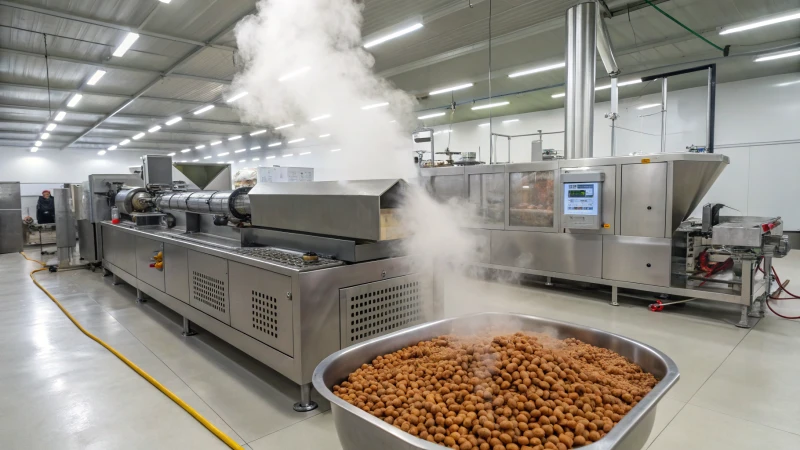
The pet food manufacturing industry is booming, but many manufacturers face inefficiencies and quality issues due to a lack of understanding of dog food machinery components. These inefficiencies can lead to increased operational costs, inconsistent product quality, and even regulatory issues. However, by understanding the key components of a dog food machine, manufacturers can improve product consistency, optimize production, and maintain high safety standards.
A dog food machine mainly consists of the following components: raw material mixer, feeder, extruder, dryer, flavoring machine, cooling conveyor, and control panel. Each part plays a crucial role in ensuring the dog food is nutritionally balanced, properly cooked, and uniformly shaped.
Want to produce high-quality dog food efficiently and economically? Understanding the role of each machine component is critical to optimizing your production process. Let’s explore in detail how each part functions and contributes to the overall system performance.
Extruders are essential in shaping and cooking dog food.Verdadeiro
Extruders use high pressure and temperature to shape and cook dog food, ensuring nutritional retention and microbial safety.
Mixers in dog food machines only mix ingredients dry.Falso
Mixers can handle both dry and wet ingredients to ensure a homogeneous mix, crucial for consistent quality.
Control panels automate the dog food production process.Verdadeiro
Modern control panels manage temperature, speed, and other variables to optimize production.
What Does a Dog Food Machine Include and How Do These Parts Work?
Dog food machines are integrated systems designed to convert raw materials into nutritious and safe pet food. To achieve this, each machine includes several core components, each performing specific functions. Let’s break down these essential parts and their roles in the production process.
The main components of a dog food machine are raw material mixers, feeders, extruders, dryers, flavoring machines, cooling conveyors, and control panels. Each component ensures the feed is safe, palatable, and nutritionally balanced for pets.
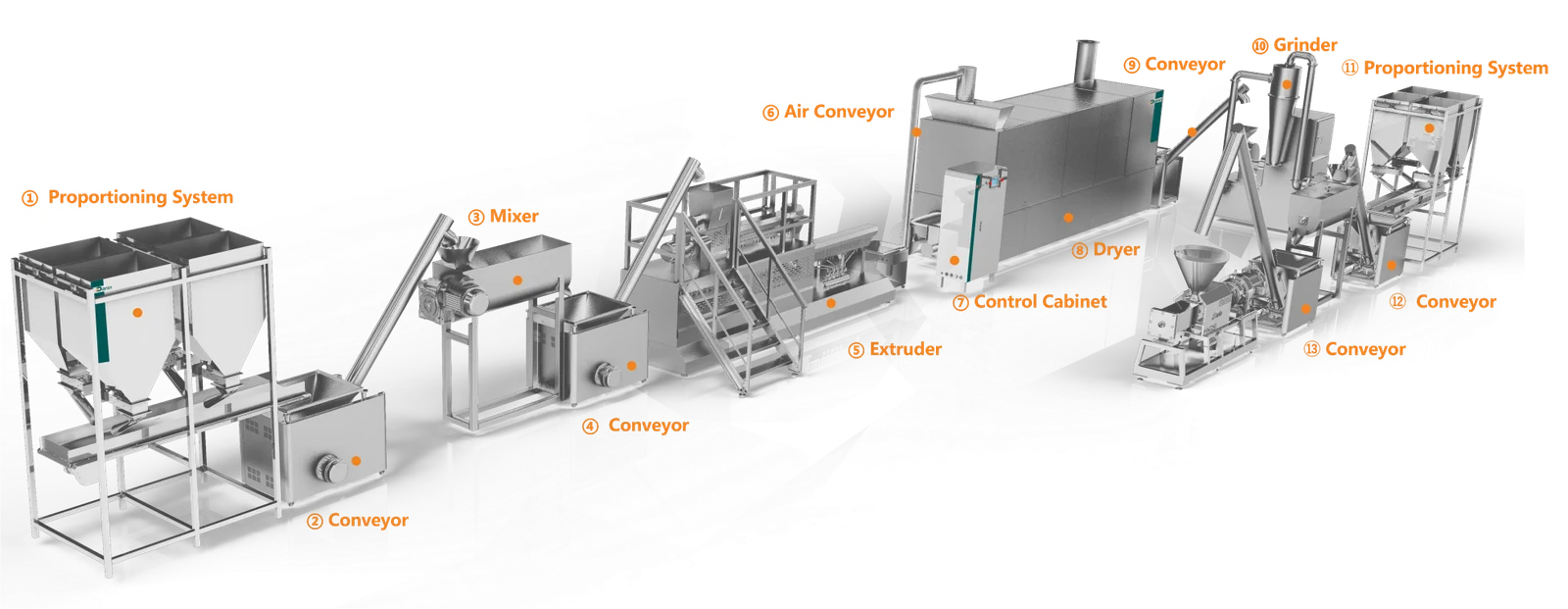
1. Raw Material Mixer: How Does It Ensure Consistency?
The raw material mixer is where everything begins. Proper mixing ensures that all ingredients — including meat meal, grains, vitamins, and minerals — are uniformly distributed before extrusion. Inconsistent mixing can result in nutritional imbalances in the final product, which can affect pet health and regulatory compliance.
The mixer uniformly blends ingredients to create a homogeneous mix, ensuring each pellet has balanced nutrition. This step is critical for product consistency and safety.
Types of Mixers:
- Horizontal Ribbon Mixers: Efficient for dry ingredients, fast mixing.
- Misturadores de pás: Ideal for wet and dry mixing, better for semi-moist formulas.
- Misturadores Contínuos: Designed for high-volume production lines.
Detalhes técnicos:
- Capacidade: 50kg to 1000kg per batch.
- Tempo de mistura: 5–10 minutes per batch.
- Consumo de energia: 3–15 kW depending on size.
Importance in Production:
A well-mixed batch ensures uniform cooking and extrusion, leading to consistent taste, texture, and appearance. Poor mixing can cause blockage in the extruder and affect pellet formation.
Estudo de caso real:
A pet food company in Germany increased batch consistency by 18% and reduced waste by 12% after upgrading to a high-efficiency ribbon mixer.
Mixers only function as preliminary units.Falso
Mixers directly affect final product quality by ensuring ingredient uniformity.
2. Feeder: How Does It Regulate Material Flow?
The feeder connects the mixer to the extruder, ensuring a steady flow of mixed materials. Without consistent feeding, the extruder’s pressure and temperature can fluctuate, leading to undercooked or improperly shaped kibble.
The feeder provides consistent, measured flow of raw mix into the extruder, critical for maintaining pressure and temperature stability.
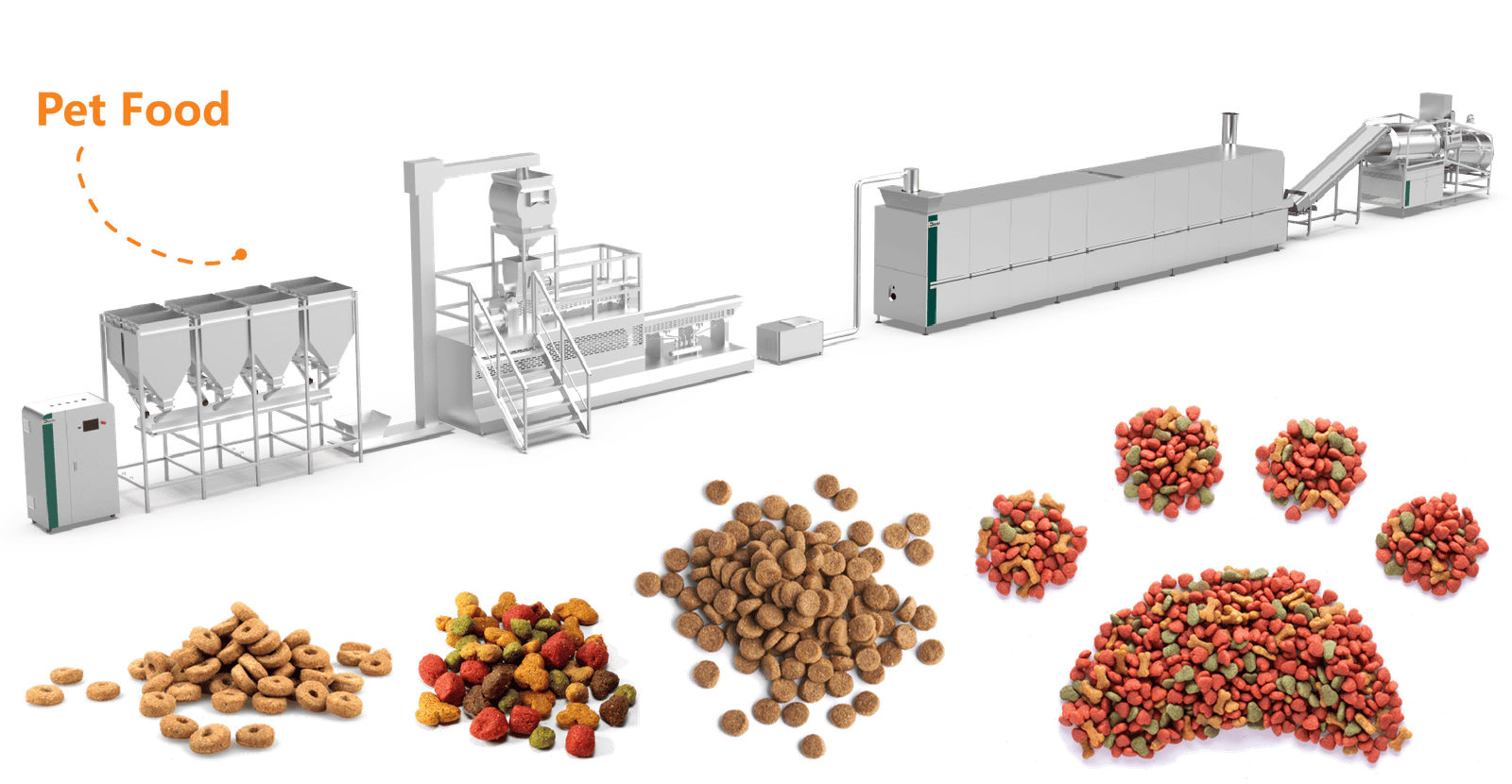
Technical Features:
- Variable Speed Drive: Controls feed rate.
- Hopper Capacity: 20–200 liters.
- Sensores: Monitor material levels to prevent overfeeding or starvation.
Efficiency Gains:
Proper feeding reduces energy consumption in extrusion and ensures uniform cooking. Feeding inconsistencies can cause extrusion surges or shutdowns.
Practical Example:
A U.S. manufacturer reported a 15% reduction in downtime after implementing an automated feeder with real-time monitoring.
Feeding systems in dog food machines require manual operation.Falso
Modern feeders are automated and use sensors for precise control.
3. Extruder: What Role Does It Play in Cooking and Shaping?
The extruder is the heart of the dog food machine. It applies high temperature and pressure to cook and shape the feed into uniform pellets. This process also kills harmful microorganisms, ensuring the safety of the final product.
The extruder cooks and shapes dog food through high-pressure, high-temperature processes, ensuring food safety and palatability.
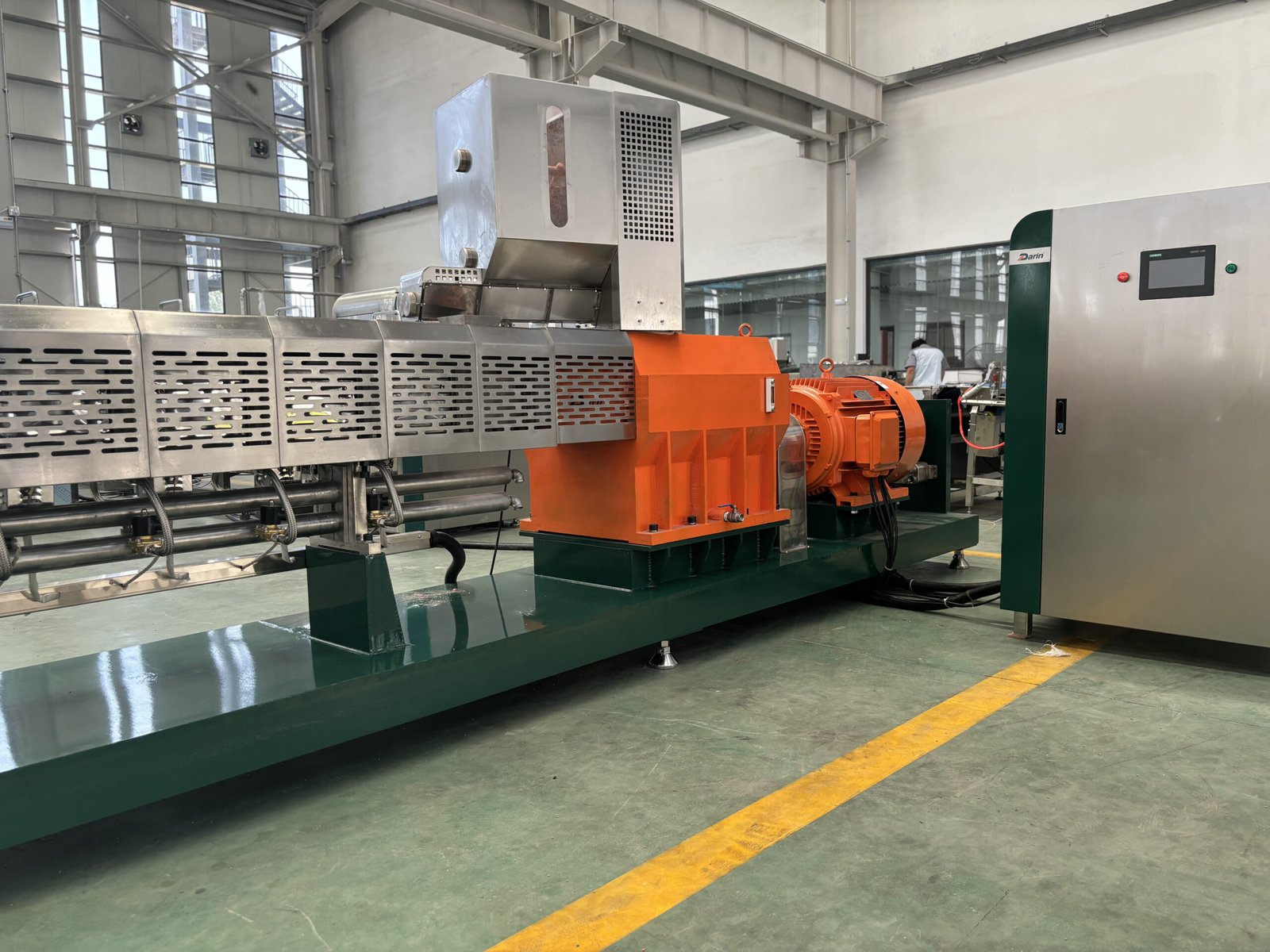
Extruder Types:
- Extrusoras de parafuso único: Simpler, cost-effective for basic production.
- Extrusoras de parafuso duplo: Better mixing, higher control, ideal for premium dog food.
Key Parameters:
| Parâmetro | Intervalo típico |
|---|---|
| Temperatura | 120°C – 180°C |
| Pressão | 30 – 60 bar |
| Rendimento | 100kg – 5,000kg/hr |
| Controlo da humidade | Adjustable for different recipes |
Product Versatility:
Extruders can produce different kibble shapes (round, bone, heart-shaped) and sizes (1–20mm diameter) by changing die plates.
Safety Impact:
Proper extrusion prevents contamination by pathogens like Salmonella and E. coli. Undercooked kibble can pose serious health risks.
Extruders operate at low pressure and temperature.Falso
Extrusion requires high heat and pressure to ensure proper cooking and shaping.
4. Dryer: Why Is Moisture Control Crucial?
Post-extrusion, the dog food contains high moisture, which must be reduced to prevent spoilage and ensure shelf stability. The dryer performs this task efficiently.
The dryer removes excess moisture, ensuring product stability and extending shelf life while maintaining nutritional integrity.

Tipos de secadores:
- Multi-layer Belt Dryers: Ideal for large volumes.
- Secadores de tambor rotativo: Space-efficient, suitable for smaller operations.
Especificações técnicas:
- Drying Temperature: 80°C – 140°C.
- Tempo de secagem: 15–60 minutes.
- Teor de humidade final: 8%–10% (optimal for shelf life).
Eficiência energética:
Modern dryers use recirculated air and heat exchangers to minimize energy use. Properly dried kibble prevents mold growth.
Industry Insight:
A Canadian producer extended shelf life by 30% and cut energy use by 20% with a heat-recovery belt dryer.
Dryers in dog food machines are optional.Falso
Dryers are essential for reducing moisture and preserving dog food quality.
5. Flavoring Machine: How Is Palatability Enhanced?
Flavoring is applied post-drying to enhance taste, using oils, vitamins, and flavor enhancers. This process determines if pets find the food acceptable.
Flavoring machines coat dog food with fats and flavor enhancers to improve palatability and nutritional value.
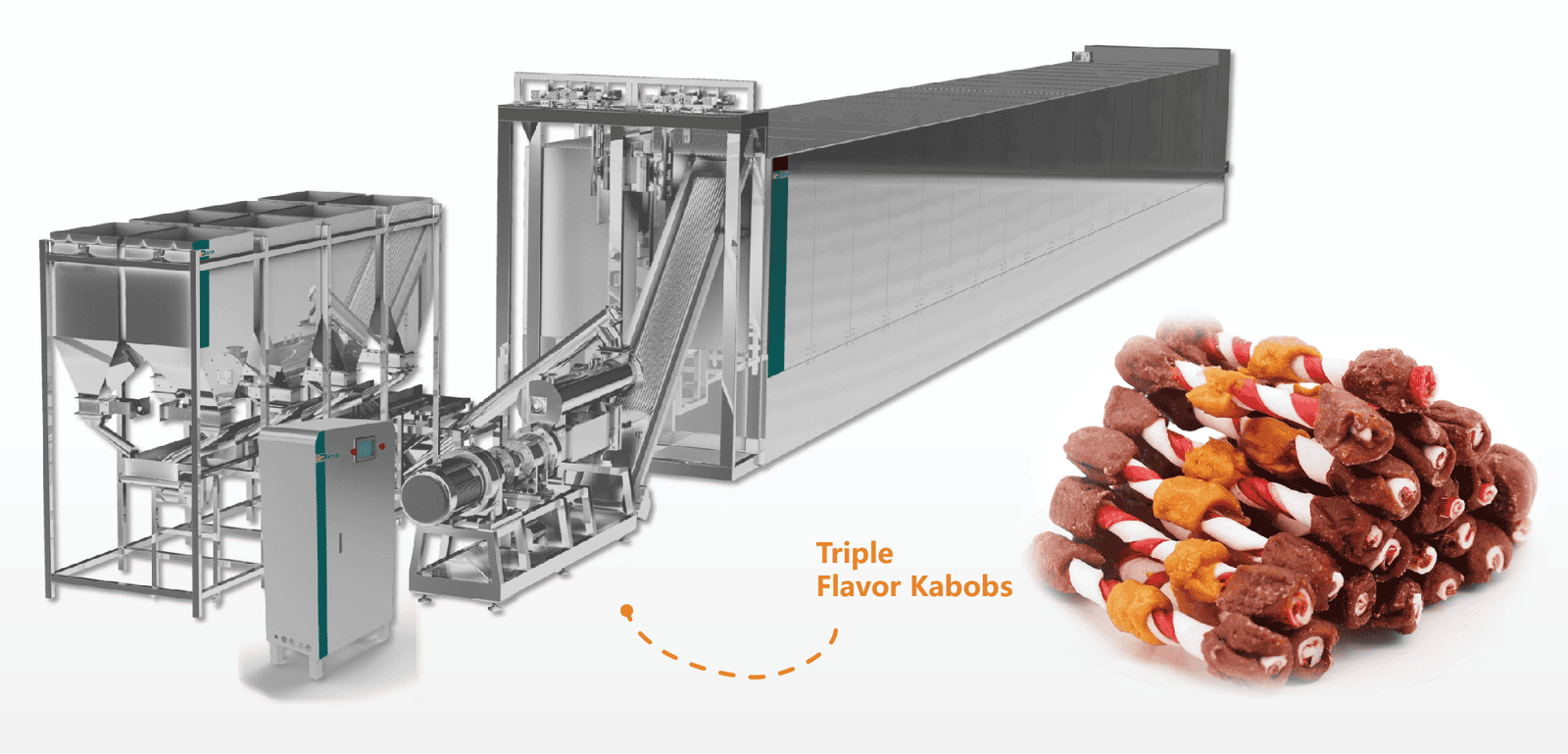
Techniques:
- Revestimento a vácuo: Ensures deep penetration of flavors.
- Spray Coating: Surface-level application for lighter recipes.
Equipment Features:
- Spray Nozzles: Adjustable for different viscosities.
- Rotation Speed: Controls evenness of coating.
Consumer Feedback:
Flavor and aroma are key to pet acceptance. Flavoring directly impacts product success in the market.
Quality Metrics:
Coating uniformity ensures consistent caloric value and appeal. Inconsistent coating can cause over- or under-consumption.
Flavoring is done before drying.Falso
Flavoring is applied after drying to preserve taste and nutrition.
6. Cooling Conveyor: Why Is It Essential for Packaging?
Cooling stabilizes the product post-flavoring, making it ready for packaging. Hot dog food can lead to condensation in packaging, causing spoilage.
The cooling conveyor lowers kibble temperature, preventing condensation and ensuring safe, long-term storage.
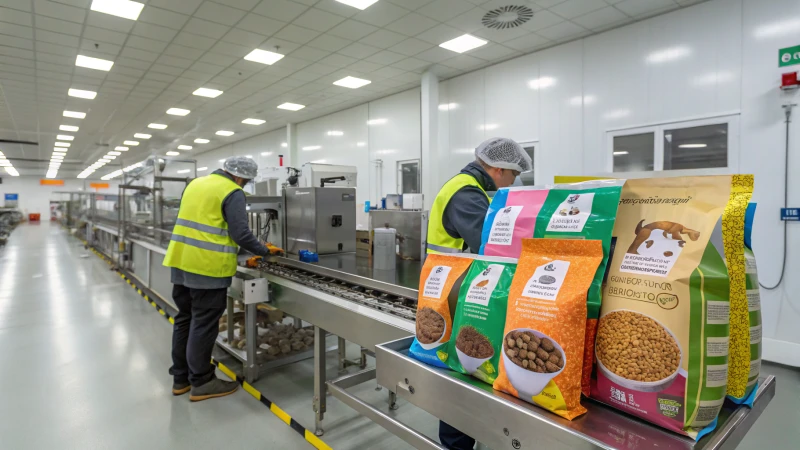
Cooling Methods:
- Ambient Air Cooling: Cost-effective, slower.
- Resfriamento de ar forçado: Faster, better for high-throughput lines.
Key Metrics:
- Cooling Time: 5–15 minutes.
- Final Temperature: Room temperature (20–25°C).
Impacto:
Proper cooling preserves product integrity and prevents packaging issues. Overheating can degrade added flavors and vitamins.
Cooling conveyors have no impact on final product quality.Falso
Cooling prevents spoilage and maintains packaging quality.
7. Control Panel: How Does It Optimize the Process?
Modern production lines rely on automated control panels for efficiency, consistency, and safety.
The control panel automates machine operations, monitors variables, and ensures process efficiency and product consistency.

Caraterísticas:
- PLC Control: Programmable for recipe changes.
- Monitorização em tempo real: Temp, pressure, speed, feed rate.
- Alarm Systems: Prevent breakdowns, ensure safety.
Benefícios:
- Productivity: Reduces manual labor.
- Consistência: Maintains quality across batches.
- Registro de dados: Useful for quality assurance and audits.
Control panels are only used for monitoring.Falso
They also automate and adjust processes for optimal production.
Conclusão
Understanding the main components of a dog food machine is crucial for efficient, high-quality pet food production. Each part — from mixers to control panels — plays a vital role in ensuring the final product is nutritious, safe, and appealing. Manufacturers who invest in high-quality machinery and understand its functions can gain a competitive advantage in the pet food market.
Contactar-nos
Ready to optimize your dog food production line? Contact us today for expert guidance, machine sourcing, and full turnkey solutions.
FAQ
Q1: What are the main components of a dog food machine?
A1: A dog food machine typically includes the feeder, extruder, cutting system, drying system, flavoring system, and control panel. Each component plays a key role in shaping, cooking, drying, and flavoring the dog food efficiently.
Q2: How does the extruder in a dog food machine work?
A2: The extruder uses heat and pressure to cook the raw ingredients and shape them into kibble. The mixture is pushed through a die, determining the size and shape of the final product, ensuring consistent quality.
Q3: Why is the drying system important in dog food production?
A3: The drying system removes moisture from the kibble, increasing its shelf life and preventing bacterial growth. Proper drying ensures the dog food remains crunchy and safe for consumption.
Q4: Can I customize the cutting system in a dog food machine?
A4: Yes, many dog food machines offer adjustable cutting systems, allowing you to control the size and shape of the kibble based on different pet dietary requirements and market demands.
Q5: What safety features should a dog food machine have?
A5: Key safety features include temperature sensors, overload protection, automatic shut-off, and easy-to-clean materials. These ensure safe operation and compliance with food safety standards.
Referências
- How Dog Food Is Made - https://www.petfoodindustry.com/articles/8231-how-dog-food-is-made - Indústria de alimentos para animais de estimação
- Dog Food Processing Equipment - https://www.extruder-machine.com/dog-food-processing-line/ - Loyal Machinery
- Understanding Pet Food Extruders - https://www.petfoodprocessing.net/articles/14981-understanding-pet-food-extruders - Processamento de alimentos para animais de estimação
- Role of Drying in Pet Food Production - https://www.petfoodindustry.com/articles/8498-importance-of-drying-in-pet-food-processing - Indústria de alimentos para animais de estimação
- Dog Food Machine Components - https://www.sbpfd.com/products/dog-food-machine - Saibainuo Machinery
- Safety in Pet Food Production - https://www.food-safety.com/articles/7203-food-safety-in-pet-food-manufacturing - Revista de Segurança Alimentar
- Flavoring Systems in Pet Food - https://www.petfoodprocessing.net/articles/15512-flavoring-pet-food - Processamento de alimentos para animais de estimação
- Choosing the Right Dog Food Machine - https://www.fishfeedextrudermachine.com/Choosing-The-Right-Dog-Food-Machine.html - Fish Feed Extruder
- Benefits of Extrusion in Dog Food Manufacturing - https://www.petfoodindustry.com/articles/8389-benefits-of-extrusion-in-dog-food-manufacturing - Indústria de alimentos para animais de estimação









